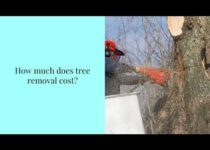Tree Removal – Can You Do it Yourself?
[ad_1]
Trees add beauty to your home’s landscape, and they provide shade, reduce erosion and block noise. But they can also pose a safety risk if they’re unhealthy or damaged, or they grow too close to buildings or power lines. If a tree is in need of removal, it can be expensive to have the job done by professionals. But if you have the right tools and follow safety protocols, it’s possible to take on the project yourself.
Before you start cutting, be sure to remove all outdoor furniture, vehicles and fire pits from the vicinity of the tree. Make sure people and pets stay out of the area during the process, as fallen limbs and debris can cause serious injuries. Also, wear safety gear like a hard hat, gloves and eye protection. If you have a chainsaw, it’s important to use it according to the manufacturer’s instructions.
It’s also important to know which way the tree will fall. You can do this by walking around the tree from all sides and observing it from different angles. This is especially helpful if the tree has a lean to it, as you can better see the problem. If the tree is in danger of hitting your home, vehicle, fence, pool or electrical line, contact a professional to avoid property damage.
In most cases, the best approach is to cut the entire tree down to a stump and remove it from your yard. This is especially beneficial if the tree is dead or has significant structural problems. But if the tree is in a difficult location, such as near power lines or other buildings, on a slope, in a rocky soil zone, or near a body of water, it may be more practical to have it removed in pieces and relocated.
Some indicators of a need for tree removal include structural defects, signs of insect infestation, decay or disease, fungus growth and a significant number of dead branches. Also, trees that are prone to breakage, drop heavy debris or produce roots that interfere with sidewalks or lawns can also be candidates for removal.
The cost of a tree removal will vary depending on the size, complexity and location of the project. The process of removing a small, non-dangerous tree is relatively straightforward and can be done by the homeowner with the proper equipment. If the tree is large, however, it’s best to have a qualified arborist handle the work.
Unless the tree is in a very safe location, such as far away from buildings and power lines, it should be cut down by a certified professional. A good arborist will have a wide variety of tools, including a saw and a crane, for the most thorough removal possible. They can even recycle the wood, a practice that cuts down on waste and promotes sustainability. They will also clean up and dispose of all wood debris from the site. If you’re considering hiring a professional, look for one who is licensed and insured.
[ad_2]


